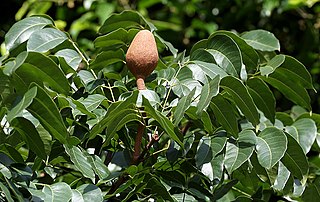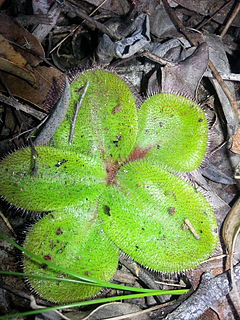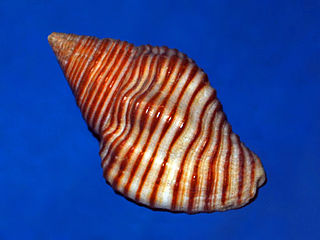
Ficus macrophylla, commonly known as the Moreton Bay fig or Australian banyan, is a large evergreen banyan tree of the family Moraceae native to eastern Australia, from the Wide Bay–Burnett region in the north to the Illawarra in New South Wales, as well as Lord Howe Island. Its common name is derived from Moreton Bay in Queensland, Australia. It is best known for its imposing buttress roots.

Ficus rubiginosa, the rusty fig or Port Jackson fig, is a species of flowering plant native to eastern Australia in the genus Ficus. Beginning as a seedling that grows on other plants (hemiepiphyte) or rocks (lithophyte), F. rubiginosa matures into a tree 30 m (100 ft) high and nearly as wide with a yellow-brown buttressed trunk. The leaves are oval and glossy green and measure from 4 to 19.3 cm long and 1.25 to 13.2 cm wide.

Hydrangea macrophylla is a species of flowering plant in the family Hydrangeaceae, native to Japan. It is a deciduous shrub growing to 2 m (7 ft) tall by 2.5 m (8 ft) broad with large heads of pink or blue flowers in summer and autumn. Common names include bigleaf hydrangea, French hydrangea, lacecap hydrangea, mophead hydrangea, penny mac and hortensia. It is widely cultivated in many parts of the world in many climates. It is not to be confused with H. aspera 'Macrophylla'.

Swietenia is a genus of trees in the chinaberry family, Meliaceae. It occurs natively in the Neotropics, from southern Florida, the Caribbean, Mexico and Central America south to Bolivia. The genus is named for Dutch-Austrian physician Gerard van Swieten (1700-1772). The wood of Swietenia trees is known as mahogany.

The wompoo fruit dove, also known as wompoo pigeon, is one of the larger fruit doves native to New Guinea and eastern Australia.

Nepenthes macrophylla, the large-leaved pitcher-plant, is a tropical pitcher plant known only from a very restrictive elevation on Mount Trusmadi in Sabah, Malaysian Borneo.

Jagera is a genus of 4 species of forest trees known to science, constituting part of the plant family Sapindaceae.
The putative Wych Elm cultivar Ulmus glabra 'Fastigiata Macrophylla' was first mentioned by Dieck in the Zöschen catalogue in 1885 as Ulmus montana forma fastigiata macrophylla, without description. Hartwig added a description in 1892. Berndt received "from a renowned nursery in Holstein" an Ulmus montana fastigiata macrophylla, possibly the same clone, in 1903, which he listed and described as Ulmus glabra fastigiata in Graf von Schwerin's Mitteilungen der Deutschen Dendrologischen Gesellschaft (1915).

Carissa spinarum, the conkerberry or bush plum, is a large shrub of the dogbane family (Apocynaceae), widely distributed in tropical regions of Africa, Southern Asia, Australia, and various islands of the Indian Ocean. It is most well known in Australia, where it is also called currant bush or, more ambiguously, native currant or even black currant. It is, however, neither closely related to plums (Prunus) nor to true currants (Ribes), which belong to entirely different lineages of eudicots. In India, it is also called wild karanda /wild karavanda, referring to the related karanda. Carissa spinarum is often discussed under its many obsolete synonyms.

Pseuduvaria is a genus of the plant family Annonaceae and tribe Miliuseae: with a native range is Tropical Asia.

Swietenia macrophylla, commonly known as mahogany, Honduran mahogany, Honduras mahogany, or big-leaf mahogany is a species of plant in the Meliaceae family. It is one of three species that yields genuine mahogany timber (Swietenia), the others being Swietenia mahagoni and Swietenia humilis. It is native to South America, Mexico and Central America, but naturalized in the Philippines, Singapore, Malaysia and Hawaii, and cultivated in plantations and wind-breaks elsewhere.

Drosera macrophylla, the showy sundew, is a perennial tuberous species in the genus Drosera that is endemic to Western Australia. It grows in a rosette with leaves 4 cm (2 in) long and 2 cm (1 in) wide. It is a common species east of Perth. It grows in loam soils. It flowers from June to October. D. macrophylla was first described by John Lindley in his 1839 publication A sketch of the vegetation of the Swan River Colony. In 1992, Allen Lowrie and Sherwin Carlquist described a new subspecies, D. macrophylla subsp. monantha, which is distinguished from D. macrophylla subsp. macrophylla by its single-flowered or rarely biflowered inflorescences. Subspecies monantha is abundant in the Bruce Rock/Merredin region.

Pisania is a genus of marine whelk in the family Pisaniidae. Some species prey on barnacles.

Pollia is a genus of sea snails, marine gastropod mollusks in the family Pisaniidae.

Wilkiea is a genus of dioecious trees and shrubs in the Mollinedieae tribe of the family Monimiaceae. They grow in Australia and New Guinea. Mostly with toothed leaves which have short leaf stems. Leaves with many oil dots. The genus appears to have an Australian or southern origin.

Pollia is a genus of flowering plants in the family Commelinaceae, first described in 1781. It is widespread through the Old World Tropics: Africa, southern Asia, northern Australia, etc. There is also one species endemic to Panama.
Synima is a genus of tropical rainforest trees, constituting part of the plant family Sapindaceae.
Ophyx ochroptera is a moth of the family Erebidae first described by Achille Guenée in 1852. It is found in Australia, where it has been recorded from Queensland and New South Wales. The habitat consists of rainforests.

General Philip Henry Sheridan, also known as the Sheridan Memorial, is an outdoor bronze sculpture of Philip Sheridan by Joseph Pollia, located in Christopher Park in Manhattan, New York. The statue was installed in 1936.

Pollia crispata is a perennial herb found in rainforest or rainforest margins in eastern Australia. The specific epithet crispata is derived from Latin, meaning "wavy". Found from near Nowra in New South Wales to tropical Queensland.
















